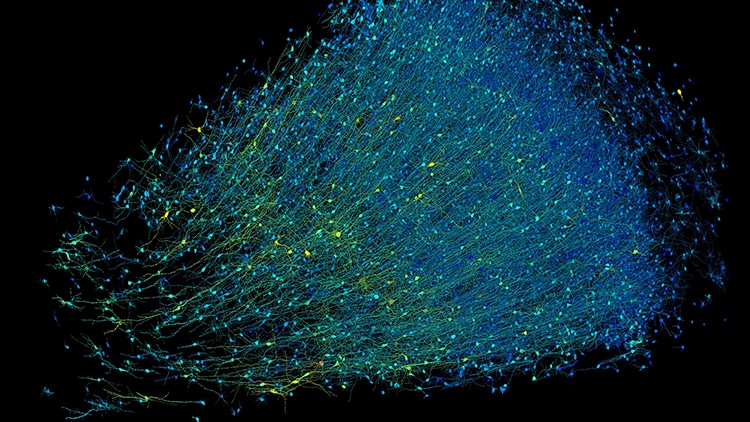
Photo: Google Research & Lichtman Lab (Harvard University)/Rendering by D. Berger (Harvard University)/CC4.0
The human brain is one of the most significant objects in the world, and also one of the most complex. Yet that three pounds of tissue that mediates every moment of our lives, every decision, every reflex, every emotion, is essentially still a mystery to scientists. A recent joint effort by Harvard and Google research teams has extracted an incredible amount of data from just 3 mm of brain tissue. With machine-learning modeling, the team created the world's highest-resolution brain tissue map. This brain map lets researchers see 57,000 cells and 150 million synapses, which are connections between the neurons.
While the brain tissue was only the size of half a rice grain, the raw data produced by the study is equivalent to 2,800 laptops worth of storage capacity or 14,000 full length movies. “It’s a little bit humbling,” Viren Jain, a co-author of the study and neuroscientist at Google, told Nature News. “How are we ever going to really come to terms with all this complexity?”
The researchers have openly published the 1.4 petabytes of raw data so that anyone can use and review the data themselves to untangle some of the complexities of the brain.
The brain tissue comes from a 45-year-old woman who had undergone surgery to address her epilepsy. This was a rare instance of live brain tissue for the researchers to preserve in resin, as brain biopsies are rare and usually only of tumors. Additionally, cadavers, which are often used in medical research, are not helpful because brains decompose quickly.
Once the scientists had preserved the tissue, they had to cut it into 5,000 slices that were 30 nanometers thick. Those slices were then examined through an electron microscope made specifically for this study. This took over a year, but then artificial intelligence took over to reconstruct the images correctly, making sure each neuron had the correct synapses connected to it.
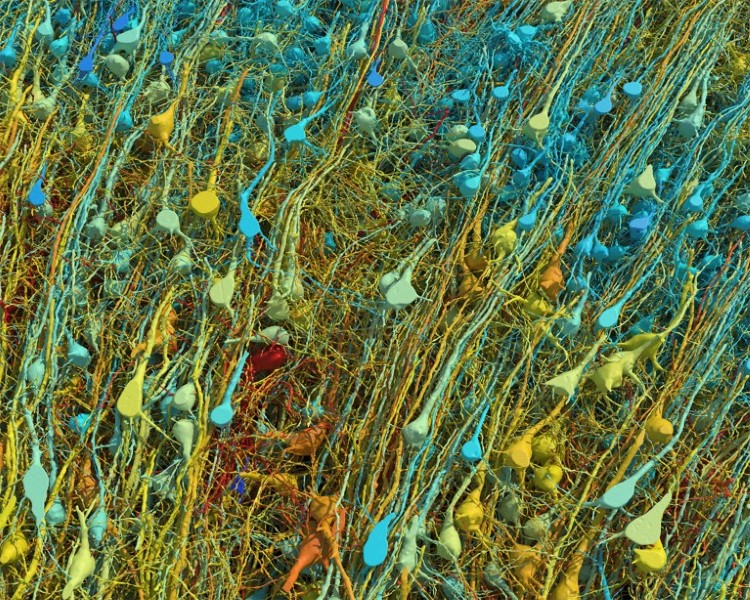
Rendering based on electron-microscope data, showing the positions of neurons in a fragment of the brain cortex. Neurons are colored according to size. (Photo: Google Research & Lichtman Lab (Harvard University)/Rendering by D. Berger (Harvard University)/CC4.0)
The 3D reconstruction, complete with all tissue elements such as glial cells, blood vasculature, and the myelin sheath that wraps around the neuron, has already produced surprising results. Jeff Lichtman, the molecular and cell biologist who heads the Harvard lab that worked on the project shares, “there were just so many things in it that were incompatible with what you would read in a textbook.”
One of the most intriguing findings is the multiple neurons connected to many synapses, including, in one case, 50.96% of neurons only connect to one synapse with 99% having fewer than three synapse connections. Scientists are not sure what these extra-connected neurons mean for sure, but the current theory is that this might be what a well-learned response that takes little thought looks like. For instance, moving your foot to brake is so engrained in experienced drivers' minds that they aren't consciously thinking about it.
Several other facts that surprised scientists include the fact that pyramidal neurons, which have dendrites—the branches that carry information away from a neuron—are symmetrical. Also, they found axons—branches that carry information from a synapse to the cell body—that formed whorls, going in circles around themselves, which had never been seen before. It's easy to see how, with more eyes thoroughly reviewing the data, many more paths for neuron research will open up.
Brain maps have been created before, starting in 1986 when 302 neurons were mapped in a roundworm. More complex maps from other species have slowly been created, but it will take years and technological advances for a fully mapped human brain at this resolution. Until then, the team has mapped the hippocampus of a mouse, which has a fairly similar brain to humans in terms of structure and neuron composition. If successful, a mapped mouse brain may give some insight into how humans learn and even free will.
Harvard and Google researchers published the most in-depth map of brain tissue to ever be created.
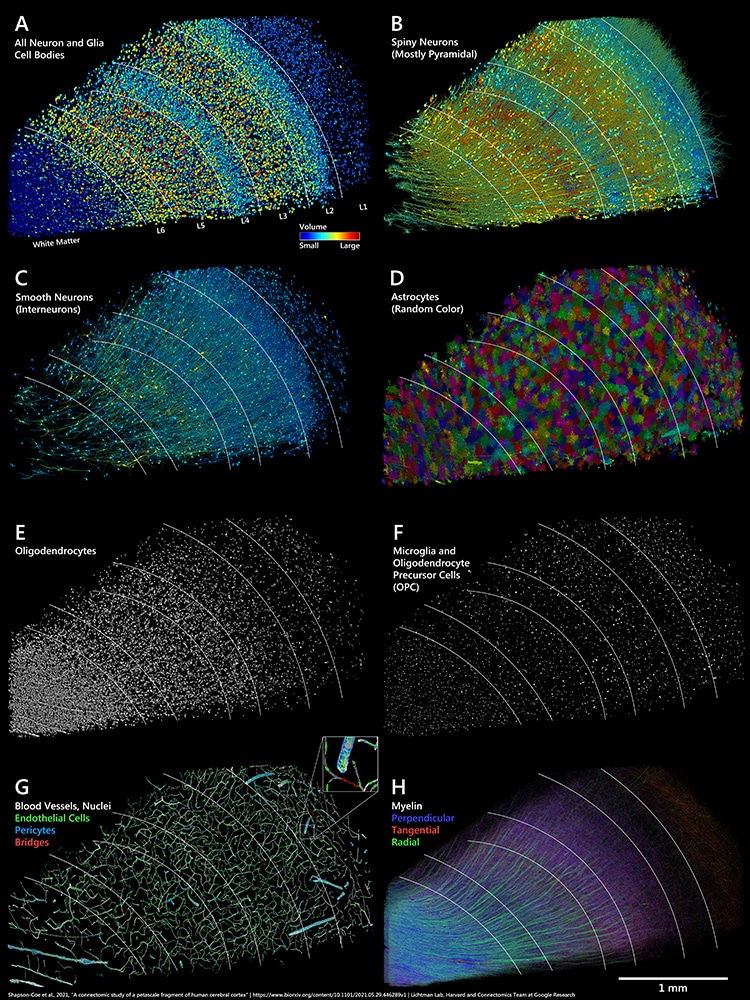
Distribution of cells, blood vessels and myelin in the sample. White lines in all panels indicate approximate layer boundaries estimated from cell clustering. A: All 49,080 manually labeled cell bodies of neurons and glia which were found in the sample, colored by cell body volume. B: All neurons classified as spiny cells (putatively excitatory), extracted from the C3-agglomerated. (Photo: Google Research & Lichtman Lab (Harvard University)/Rendering by D. Berger (Harvard University)/CC4.0)
The sample's density was 16,000 neurons per cubic millimeter—almost a third lower than previous estimates.
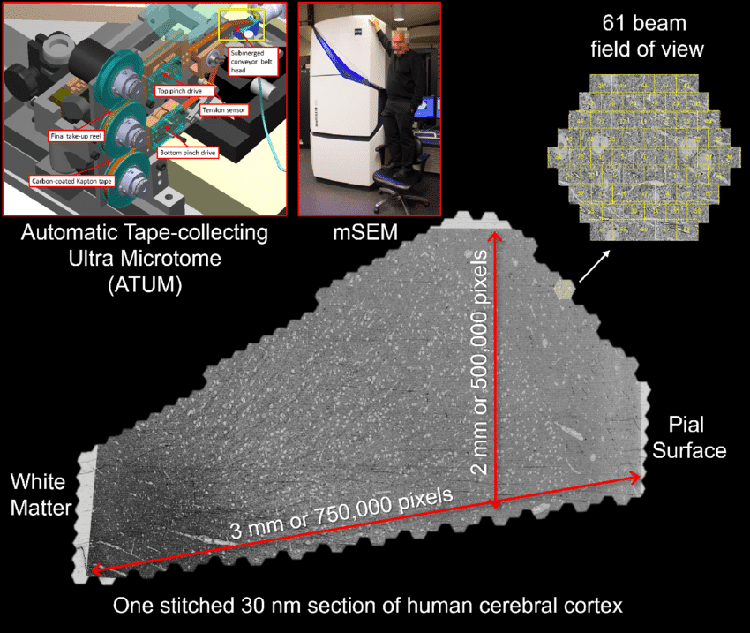
Image acquisition for the human brain sample. A fresh surgical cerebral cortex sample was rapidly preserved, then stained, embedded in resin, and sectioned. More than 5000 sequential ~30 nm sections were collected on tape using an ATUM (upper left panel). Yellow box shows the site where the brain sample is cut with the diamond knife and thin sections are collected onto the tape. The tape was then cut into strips and imaged in a multibeam scanning electron microscope (mSEM). This large machine (see middle panel with person on chair as reference) uses 61 beams that image a hexagonal area of about ~10,000 μm 2 simultaneously (see upper right). For each thin section, all the resulting tiles are then stitched together. One such stitched section is shown (bottom). This section is about 4 mm 2 in area and was imaged with 4 x 4 nm 2 pixels. Given the necessity of some overlap between the stitched tiles, this single section required collection of more than 300 GB of data.(Photo:GOOGLE RESEARCH & LICHTMAN LAB, HARVARD UNIVERSITY / D. BERGER (RENDERING)/CC4.0)
The sample was taken from the left anterior lobe, which is thought to deal with our knowledge of words, objects, people, and facts.

A: Fine-scale alignment with optical flow. Left: An XZ cross-section of the initial coarsely aligned subvolume exhibits drift and single-section jitter. Two adjacent XY sections z and z-1 are extracted. Center: z and z-1 are overlaid to illustrate their misalignment (z is pseudo-colored green for contrast). Image patch-based cross-correlation is used to compute an XY flow field between the sections. Red and blue intensity indicate the magnitude of the horizontal and vertical flow components respectively. The flow field is then used to warp one of the sections, improving the alignment apparent in the overlay. Right: XZ view of the same subvolume with flow realignment applied throughout. Scale bar: 2 μm. B: Sequential segmentation of a subvolume with an FFN. XY cross-sections illustrate the 3D segmentation process. Each yellow crosshair indicates the seed location for the next segment. Scale bar: 1 μm. C: FFN agglomeration.(Photo: Google Research & Lichtman Lab (Harvard University)/Rendering by D. Berger (Harvard University)/CC4.0)
The raw data has been published online so that anyone can use and review the data themselves to untangle some of the complexities of the brain.
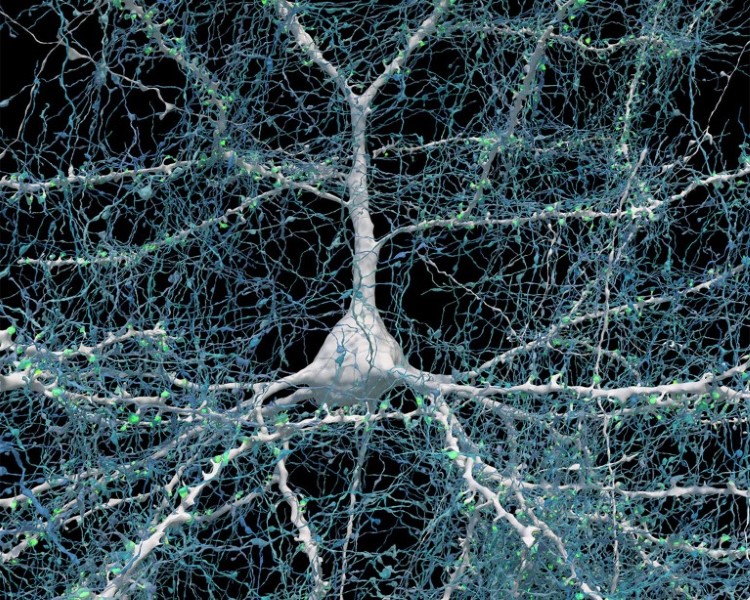
A single neuron (white) shown with 5,600 of the axons (blue) that connect to it. The synapses that make these connections are shown in green. (Photo: Google Research & Lichtman Lab (Harvard University)/Rendering by D. Berger (Harvard University)/CC4.0)
h/t: [Smithsonian Magazine]
Related Articles:
Researchers Discover That Your Brain’s Mental Speed Doesn’t Decline Until Your 60s
Spectacular Visualizations of Brain Scans Enhanced with 1,750 Pieces of Gold Leaf
Scientists Develop Brain Implant That Translates Paralyzed Man’s Thoughts Into Text
World’s Oldest Preserved Brain Found in a 319 Million-Year-Old Fish Fossil






















































































